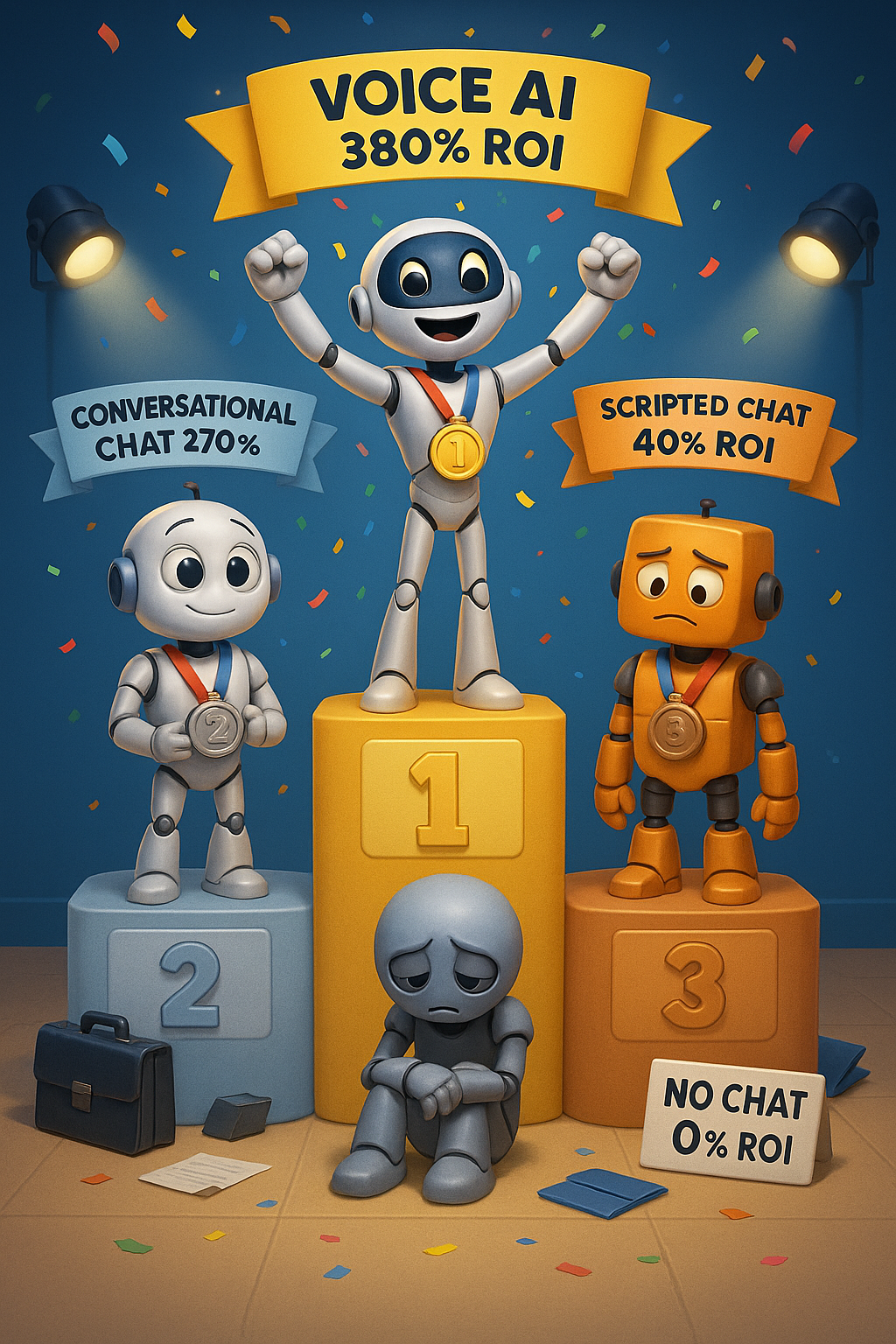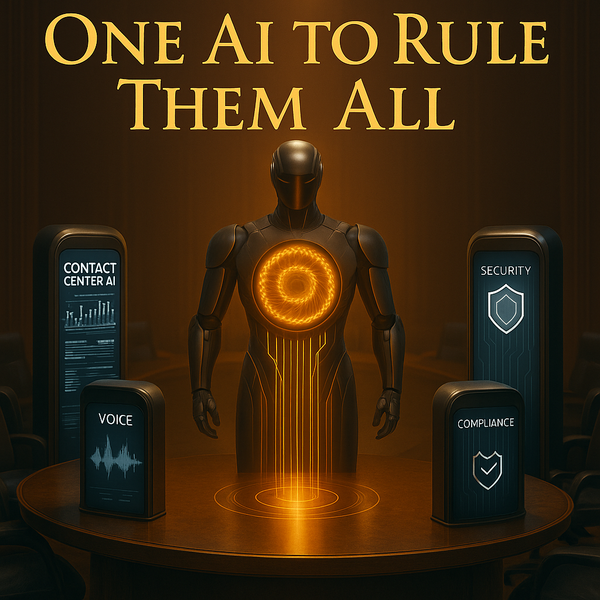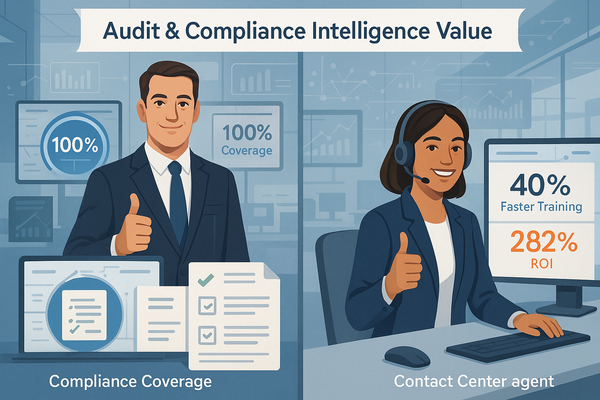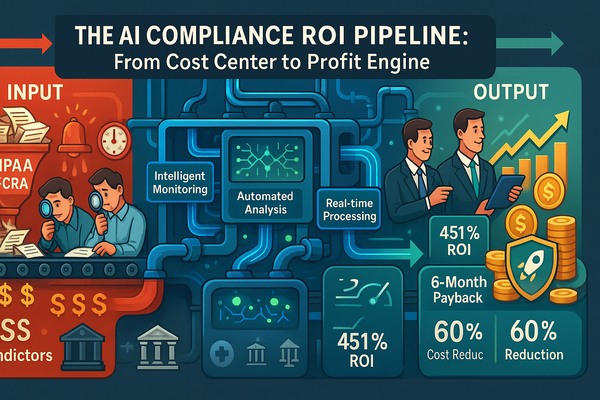Voice AI vs. Chat: The 340% ROI Gap That's Reshaping Enterprise Strategy

Executive Summary: While both conversational AI chat and voice AI use similar underlying technology, enterprise voice implementations deliver dramatically superior ROI - with documented returns reaching 380% versus typical chat deployments at 40-60%. The gap isn't just about technology capabilities; it's about fundamental differences in customer behavior, completion rates, and operational efficiency. Enterprises making strategic AI investments in 2025 must understand why voice consistently outperforms even advanced conversational chat platforms.
The Technology Context: Why This Comparison Matters
First, let's establish the playing field. Unlike traditional chatbots, which follow scripted paths, ChatGPT-style conversational AI can understand subtle user input and respond with more personalized, human-like text. Modern conversational AI chat represents a massive leap forward from rule-based systems, improving resolution rates by 300-500% and enabling genuine contextual conversations.
Yet despite this advancement, voice AI consistently delivers superior enterprise ROI. Here's why the numbers tell such a compelling story.
By the Enterprise Numbers: The Voice AI Advantage
The ROI Reality Split:
Voice AI Performance Benchmarks:
- 331% three-year ROI and sub-six-month payback periods (Forrester)
- 380% ROI in voice-based customer service for well-executed enterprise deployments (Retell AI)
- 30-50% operational cost reductions and 25-40% CSAT increases within just three months (Plivo)
- Up to 90% automation, 60% reduction in operational costs, 40-60% increase in customer satisfaction (Yellow.ai)
Conversational AI Chat Performance:
- 270% return over three years for advanced chat implementations (MasterOfCode)
- 42-66% reduction in escalations requiring human intervention (MasterOfCode)
- 80% CSAT score for chatbot-powered journeys (MasterOfCode)
The Enterprise Preference Gap: Despite advanced chat capabilities, 61% of consumers still prefer phone support for urgent problems (Retell AI), revealing a fundamental limitation in chat-based customer experience that impacts long-term ROI through customer satisfaction and retention.
The Customer Behavior Foundation: Why Voice Wins
Speed and Efficiency Multipliers:
Voice Processing Advantages:
- AI-powered tools can reduce resolution times by up to 50% through automation (Desk365)
- A large telecom company reduced call handling time by 35% with Voice AI (Verloop.io)
- Voice agents resolve repetitive queries like password resets, order tracking, and appointment scheduling—reducing human agent workload by up to 60% (Yellow.ai)
The Human Communication Reality: Voice is one of the most powerful unlocks for AI application companies. It is the most frequent (and most information-dense) form of human communication, made "programmable" for the first time due to AI (Andreessen Horowitz). This isn't just about technology preference—it's about cognitive efficiency.
Enterprise Completion Rate Analysis:
Voice AI Task Completion:
- Over 90% task completion rate for focused voice implementations (Retell AI)
- As of 2025, Erica has handled 2 billion interactions and resolved 98% of customer queries within 44 seconds (Desk365)
- Up to 90% automation in enterprise voice deployments (Yellow.ai)
Chat Completion Reality:
- 80% CSAT score represents strong performance for conversational chat
- Goal Completion Rate (GCR) measures how effective a chatbot is in helping users reach predefined goals - but enterprise voice consistently achieves higher GCRs
Enterprise Success Story Deep Dive: The Voice vs. Chat ROI Comparison
The Voice AI Success: Bank of America's Erica
Bank of America's voice AI implementation demonstrates the upper bounds of voice ROI performance:
- Scale Achievement: 2 billion interactions handled with consistent performance
- Resolution Performance: 98% of customer queries resolved within 44 seconds
- Current Usage: Clients are engaging with Erica 56 million times per month
- Task Automation: Monitor subscriptions (3.6 million times per month), understand spending habits (2.1 million times per month), merchant refunds (863,000 times per month)
The Conversational Chat Comparison: Gupshup's WhatsApp Bot
For comparison, advanced conversational chat implementations show strong but lower performance:
- ROI Achievement: 270% return over three years
- Engagement Rates: 50% to 80% engagement rates, depending on industry and implementation
- Conversion Performance: 3x better conversion rates compared to traditional funnels
The ROI Gap Analysis: Voice AI (331-380% ROI) vs. Advanced Chat (270% ROI) = 60-110% performance advantage for voice implementations.
The Enterprise Cost Structure Reality
Voice AI Infrastructure Investment:
Higher Upfront, Superior Returns:
- ROI within 90 days for most well-executed enterprise deployments (Retell AI)
- Sub-six-month payback (Forrester)
- 60% reduction in operational costs creates sustainable competitive advantage (Yellow.ai)
The Infrastructure Advantage: Voice agents also allow businesses to be available to their customers 24/7 to answer questions, schedule appointments, or complete purchases. Customer availability and business availability no longer have to match 1:1 - eliminating the timezone and scheduling friction that limits chat effectiveness.
Chat Implementation Economics:
- Enterprise Plan: $600-$5,000/month for advanced conversational chat platforms (MasterOfCode)
- Strong performance in specific use cases but limited by text-based interaction constraints
- Fewer escalations, fewer refunds: Requests requiring human intervention dropped by 42–66% (MasterOfCode)
The Strategic Enterprise Implications
Why Voice AI Creates Sustainable Competitive Advantage:
1. Customer Preference Alignment 61% of consumers still prefer phone support for urgent problems despite advanced chat options (Retell AI). Voice AI serves this preference while delivering automation efficiency.
2. Information Density Advantage Voice is the most frequent (and most information-dense) form of human communication (Andreessen Horowitz), enabling faster problem resolution and higher customer satisfaction scores.
3. Scalability Without Friction For enterprises, AI directly replaces human labor with technology. It's cheaper, faster, more reliable — and often outperforms humans (Andreessen Horowitz). Voice implementations achieve this replacement more completely than chat.
4. Market Evolution Leadership By 2025, AI is projected to handle 95% of all customer interactions, encompassing both voice and text (Desk365). Organizations positioning for voice AI dominance capture this transition advantage.
Enterprise Implementation Framework: Voice vs. Chat Decision Matrix
Choose Voice AI When:
- Customer interactions involve complex, multi-step processes
- Emotional intelligence and empathy are critical (healthcare, financial services)
- Speed of resolution directly impacts customer satisfaction scores
- 61% consumer preference for phone support aligns with your customer base
- ROI timeline can accommodate 3-6 month implementation for 331-380% returns
Choose Advanced Conversational Chat When:
- Customers prefer asynchronous communication
- Visual elements (documents, images, links) enhance the experience
- 80% CSAT scores meet your customer satisfaction requirements
- Implementation timeline requires immediate deployment
- Integration with existing chat platforms provides lower implementation risk
The Hybrid Strategy Reality: Most successful enterprises implement both, but prioritize voice AI for high-value customer interactions and complex workflow automation, reserving conversational chat for information distribution and low-complexity support tasks.
The Future Enterprise AI Strategy
Market Trajectory Analysis:
By 2025, AI is projected to handle 95% of all customer interactions, but the distribution between voice and chat will be determined by ROI performance. Early indicators suggest:
Voice AI Market Leadership:
- 50% of consumers have made a purchase using a voice assistant (Verloop.io)
- 80% of consumers who shop via voice assistants are satisfied (Verloop.io)
- 42% of CX leaders see generative AI influencing voice-based interactions in the next two years (Zendesk)
The Enterprise Decision Framework: CX leaders who see high ROI on their support tools are 62% more likely to prioritize the enhancement of their voice channel with speech analytics, voice AI, and natural language processing (Zendesk).
Implementation Roadmap: Maximizing Voice AI ROI
Phase 1: Strategic Foundation (Months 1-2)
- Assess current customer interaction patterns and preference data
- Calculate baseline costs for existing chat and voice support operations
- Define success metrics aligned with ROI within 90 days expectations
Phase 2: Voice-First Deployment (Months 3-6)
- Implement voice AI for highest-value customer interaction scenarios
- Maintain conversational chat for information distribution and low-complexity support
- Monitor performance against 331% three-year ROI benchmarks
Phase 3: Optimization and Scale (Months 7-12)
- Expand voice AI to additional use cases based on ROI performance
- Optimize chat implementations for specific scenarios where text interaction provides advantages
- Achieve 30-50% operational cost reductions and 25-40% CSAT increases targets
What This Means for Your Enterprise AI Strategy
The Bottom Line: Both conversational AI chat and voice AI represent massive improvements over traditional systems, but voice AI's 60-110% ROI advantage creates a strategic imperative for enterprises serious about customer experience transformation.
The Strategic Decision: Organizations can implement both technologies, but resource allocation should prioritize voice AI for customer-facing interactions where speed, emotional intelligence, and completion rates drive business outcomes. Reserve advanced chat for scenarios where visual elements, asynchronous communication, or integration simplicity provide specific advantages.
The Competitive Reality: Companies that integrate Voice AI into their customer service strategy today aren't just keeping up—they're setting the standard for what great customer experience should look like.
Your enterprise AI strategy should optimize for measurable business outcomes, not technology preferences. In 2025, the data clearly shows that voice AI delivers superior ROI through higher customer satisfaction, faster resolution times, and more complete automation - making it the foundation technology for customer experience transformation.
The choice isn't between voice AI and conversational chat - it's between leading with voice AI while strategically deploying chat, or accepting lower ROI by prioritizing text-based interactions over the communication medium customers prefer for complex, urgent problems.
Sources and References
[1] AI Voice Agent ROI For Enterprise Communications, Retell AI, 2025 [2] Introducing "State of Voice AI 2025": The Year of Human-like Voice AI Agents, Deepgram, 2025 [3] AI Voice Agents: 2025 Update, Andreessen Horowitz, March 7, 2025 [4] Top 10 Enterprise AI Voice Agent Vendors 2025, Retell AI, 2025 [5] Chatbot vs ChatGPT: Differences & Features in 2025, AIMultiple, June 11, 2025 [6] BEST Chatbot Statistics [2025 Updated], MasterOfCode, 2 weeks ago [7] 61 AI Customer Service Statistics in 2025, Desk365, 2 weeks ago [8] 30+ Voice AI Stats for 2025, Verloop.io, February 19, 2025 [9] AI Agent Statistics for 2025: Adoption, ROI, Performance & More, Plivo, May 21, 2025 [10] 59 AI customer service statistics for 2025, Zendesk, 3 weeks ago [11] How AI-Powered Voice Assistants Like Yellow.ai VoiceX Are Redefining Customer Support & Sales in 2025, Yellow.ai, May 7, 2025 [12] What is Goal Completion Rate (GCR) in Chatbots?, Kommunicate, 2025



